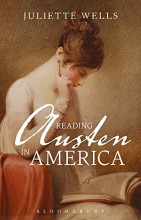Vicki J Kondelik
Posts by Vicki J Kondelik

Two time travelers from a future world arrive in 1815 to retrieve a lost manuscript and letters by Jane Austen. They are forbidden to change the past, but as they come to know Austen and her family, they decide to try to save her life. Whether they succeed or not, I will not say, but this is a suspenseful and thought-provoking novel, an intriguing combination of science fiction and Jane Austen spin-off.

Reading Austen in America is an in-depth study of Jane Austen's earliest American readers. Author Juliette Wells focuses on the 1816 Philadelphia edition of Emma, the only edition of one of Austen's works to be published in the U.S. during her lifetime. Only six copies of this edition are known to exist today. Wells writes about the lives of the original owners of these copies, and their reactions to Austen's novels and characters. Later she discusses two transatlantic friendships that developed through a mutual love of Austen's works.

The Duke's Children is the last novel in Anthony Trollope's Palliser series, about Parliamentary politics in Victorian England. It's a classical story of generational conflict, as the Duke of Omnium, former Prime Minister, struggles to come to terms with his three grown children's choices in love and politics.

In Lavinia, Ursula K. Le Guin, author of the Earthsea series and many other works of science fiction and fantasy, gives voice to a forgotten character from Virgil's Aeneid. Lavinia, daughter of King Latinus of Latium, rejects all her suitors because of a prophecy that says she's destined to marry a foreigner. When Aeneas and his fellow survivors of the Fall of Troy arrive in Latium, she knows he is the man she's meant to marry, but one of her suitors, Turnus, has other ideas, and they fight a war over her--a war she never wanted. Le Guin writes beautifully of ancient Italy, and especially of its religious rites and ceremonies.

Jane Austen in Performance is a study of Jane Austen's enduring popularity, from the 19th century to the present day. Author Marina Cano discusses such topics as the use of Jane Austen by the women's suffrage movement, Austen's popularity during and immediately after World War I, film and theatrical adaptations of her works, and fan fiction based on her novels.

This historical novel, originally published in 1936, tells the story of Luisa Sanfelice, an impoverished noblewoman in Naples, Italy, at the time of the French Revolution. When revolutionaries briefly take over Naples and overthrow the king and queen, Luisa, a woman of no strong political beliefs, inadvertently becomes a heroine of the revolution when she warns her revolutionary lover about a royalist plot to re-take the city. Much violence ensues, and Sheean's descriptions are not for the squeamish. But Sanfelice makes for a compelling read. The heroine's story has been told several other times, most notably by Alexandre Dumas.

Ancient Roman detective Marcus Didius Falco travels to Germany on a mission for the Emperor Vespasian, to discover what happened to a missing general and to negotiate peace with a powerful Druid priestess. The emperor's son Titus wants Falco out of the way because he has his eye on Falco's girlfriend Helena Justina. Is the barber who Titus sent along with Falco really an assassin? And will Falco have to give up Helena for the good of Rome? Unlike other books in the series, this is more of an adventure novel than a mystery, and it includes plenty of action in the forests of Germany.

In this third mystery in Donna Leon's long-running series set in Venice, Commissario Guido Brunetti investigates the murder of a transvestite whose face was damaged beyond recognition. It turns out that the victim was one of Venice's most prominent bankers, and Brunetti uncovers a scandal involving financial fraud and illegally rented apartments. Meanwhile, he longs to solve the case quickly to avoid becoming the next victim and to escape the heat of August in Venice and join his wife Paola and teenage children on vacation in the mountains. As usual with Leon, the book features Paola's mouth-watering meals, and Brunetti does some cooking for himself this time.

Glass Houses is the latest entry in Louise Penny’s long-running mystery series featuring Chief Superintendent Armand Gamache of the Sûreté de Québec, who lives in the tiny village of Three Pines. After Three Pines' Halloween party, a mysterious figure in a black cloak haunts the village green. Two days later, the figure disappears, but the body of a woman, a visitor to Three Pines, is found wearing the cloak. The story of the murder alternates with the trial of the person accused of it, several months later. Meanwhile, Gamache is trying to capture the head of the most powerful drug cartel in Québec. There is, of course, a connection between the drug trade and the murder in Three Pines, but part of the suspense is figuring out what it is.

Ancient Roman detective Flavia Albia has been hired by palace officials working for the paranoid emperor Domitian to investigate a conspiracy involving a man who pretends to be the emperor Nero. Meanwhile, the newly-married Flavia cares for her husband, who's survived being struck by lightning but has never been the same since, and contends with a series of domestic troubles.